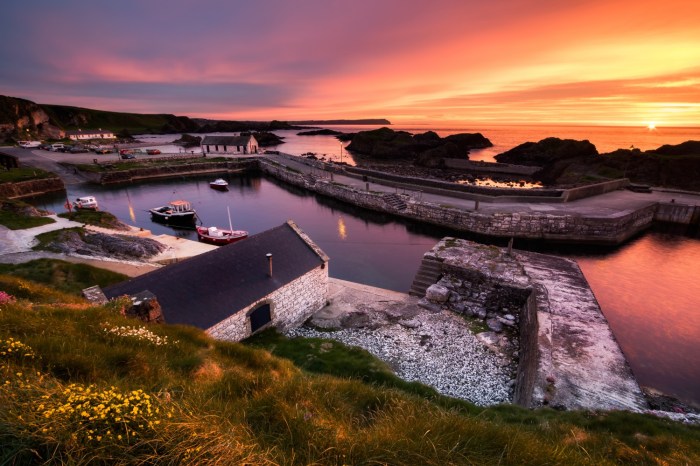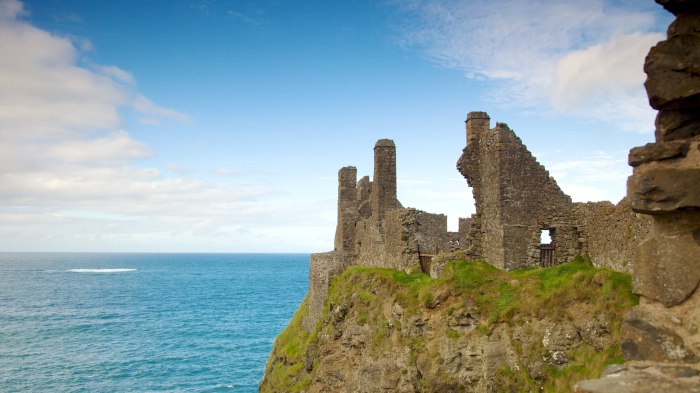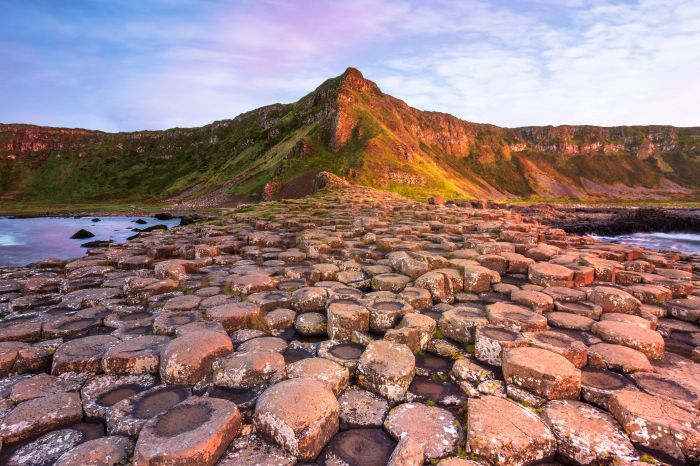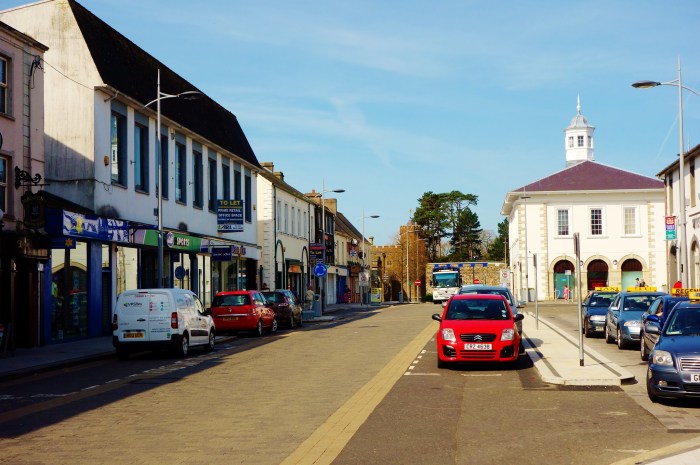Antrim, a captivating county nestled in Northern Ireland, beckons with its rich history, vibrant culture, and thriving economy. From its ancient origins to its modern-day achievements, Antrim has left an indelible mark on the tapestry of Ireland.
Antrim’s diverse landscape, boasting rolling hills, tranquil rivers, and dramatic coastline, provides a breathtaking backdrop for its charming towns and villages. Its unique cultural heritage shines through its traditional festivals, vibrant arts scene, and renowned musical traditions.
History of Antrim
Antrim, a historic county in Northern Ireland, boasts a rich and captivating past that has shaped its present-day identity. The county’s history is intertwined with significant events and influential figures, leaving an indelible mark on its cultural heritage and physical landscape.
The origins of Antrim can be traced back to ancient times, with evidence of human habitation dating back to the Neolithic period. The county’s name, derived from the Irish “Aontroim,” meaning “lone ridge,” reflects its geographical features. During the Iron Age, Antrim was inhabited by the Gaelic tribe known as the Dál Riata, who established a stronghold in the area.
Antrim, with its stunning coastline, is a popular destination for beach holidays. Before you pack for your trip, be sure to consult a beach holiday packing list to ensure you have everything you need to make the most of your time in Antrim.
Early History
In the 5th century AD, Saint Patrick is believed to have visited Antrim and established a monastery on the site of the present-day Antrim town. The county became a center of Christian learning and spirituality, with several monasteries and churches founded throughout the region. During the Viking era, Antrim was subject to raids and settlements, with the Vikings establishing a trading post at Carrickfergus.
Geography of Antrim

Antrim, a county in Northern Ireland, boasts a diverse geographical landscape characterized by rolling hills, picturesque valleys, and a rugged coastline. Its topography, climate, and natural resources have played a significant role in shaping the region’s history and culture.
Topography
Antrim’s topography is predominantly hilly, with the Antrim Hills forming a prominent feature in the county’s northwest. These hills, reaching elevations of up to 600 meters, provide breathtaking panoramic views of the surrounding countryside. The valleys between the hills are fertile and provide agricultural land for farming and grazing.
Climate
Antrim enjoys a temperate oceanic climate, influenced by the Atlantic Ocean. The county experiences mild temperatures year-round, with average winter temperatures hovering around 5 degrees Celsius and summer temperatures reaching an average of 18 degrees Celsius. Rainfall is evenly distributed throughout the year, with the wettest months being December and January.
Natural Resources
Antrim is rich in natural resources, including fertile soils, abundant water, and mineral deposits. The county’s agricultural sector benefits from the fertile soils, which support a variety of crops, including potatoes, cereals, and livestock. Antrim is also home to several rivers and lakes, which provide water for drinking, irrigation, and hydroelectric power generation.
Notable Landmarks
Antrim boasts several notable landmarks, including:
- Giant’s Causeway: A UNESCO World Heritage Site, this natural rock formation consists of thousands of hexagonal basalt columns, creating a breathtaking coastal landscape.
- Carrickfergus Castle: A medieval castle built in the 12th century, it is one of the best-preserved Norman castles in Ireland.
- Lough Neagh: The largest freshwater lake in the British Isles, Lough Neagh is home to a variety of wildlife, including birds and fish.
Culture of Antrim
Antrim boasts a rich and diverse cultural heritage that reflects its unique history and geographic location. From traditional music and dance to vibrant festivals and a thriving arts scene, Antrim offers a captivating cultural experience.
Local Traditions and Customs
Antrim is renowned for its strong sense of community and deep-rooted traditions. The county is home to a number of traditional festivals, including the Antrim Agricultural Show, which showcases the region’s farming and agricultural heritage, and the Dunluce Medieval Festival, which celebrates the area’s medieval history.
Traditional music and dance are also integral to Antrim’s culture. The county is home to several renowned traditional music groups, including the Antrim Traditional Music Society and the Cushendall Folk Group. Traditional Irish dance is also popular, with several dance schools and clubs operating throughout the county.
Arts, Music, and Literature
Antrim has a vibrant arts scene, with a number of galleries, theaters, and performance venues. The county is home to several renowned artists, including the painter William Conor and the sculptor John Behan. Antrim is also home to a number of literary festivals, including the Belfast Book Festival and the Seamus Heaney HomePlace International Poetry Festival.
Antrim is an enchanting land of verdant hills and tranquil lakes. While there, immerse yourself in the lap of luxury with luxury travel deals. Indulge in exquisite dining, rejuvenating spa treatments, and opulent accommodations. Antrim’s allure extends beyond its natural beauty, offering a tapestry of cultural and historical experiences.
Immerse yourself in the rich heritage of the region, from ancient castles to vibrant local traditions.
Antrim’s rich cultural heritage is a testament to the county’s unique history and geography. From traditional music and dance to vibrant festivals and a thriving arts scene, Antrim offers a captivating cultural experience that is sure to leave a lasting impression.
Economy of Antrim

Antrim’s economy is diverse, with a strong focus on agriculture, tourism, and manufacturing. The county is home to several large-scale industries, including the agri-food, engineering, and construction sectors. In recent years, there has been a growing emphasis on developing the county’s tourism industry, which is supported by Antrim’s rich cultural heritage and natural beauty.
Employment
Antrim has a workforce of approximately 120,000 people. The largest sectors of employment are agriculture, manufacturing, and tourism. The county is also home to a number of large-scale employers, such as Moy Park, Wrightbus, and Bombardier Aerospace.
Trade
Antrim’s main trading partners are the United Kingdom, the Republic of Ireland, and the European Union. The county exports a wide range of goods and services, including agricultural products, manufactured goods, and tourism services.
Investment
Antrim has attracted significant investment in recent years, particularly in the areas of manufacturing, tourism, and renewable energy. The county is home to a number of foreign-owned companies, such as Moy Park, Wrightbus, and Bombardier Aerospace.
Challenges
The Antrim economy faces a number of challenges, including:
– The county’s dependence on a small number of large employers
– The impact of Brexit on trade and investment
– The need to diversify the economy and create new jobs
Opportunities
Despite these challenges, the Antrim economy has a number of opportunities for growth, including:
– The development of the tourism industry
– The growth of the renewable energy sector
– The expansion of the agri-food industry
Infrastructure of Antrim

Antrim’s infrastructure provides a strong foundation for the community and businesses. It includes transportation systems, utilities, and other services that support the daily lives of residents and facilitate economic growth.
The transportation network in Antrim comprises a well-maintained road system, including highways, arterial roads, and local streets. Public transportation is provided by buses, connecting Antrim to neighboring towns and cities. The nearest airport is located approximately 30 miles away, offering convenient access to regional and international destinations.
Utilities
Antrim’s utilities are reliable and efficient, ensuring a high quality of life for residents and businesses. The electricity grid provides a stable power supply, while the water and sewage systems meet modern standards. Natural gas is also available in many areas, providing an alternative energy source for heating and cooking.
Other Infrastructure
Other infrastructure in Antrim includes telecommunications networks, educational facilities, and healthcare services. High-speed internet access is widely available, supporting businesses and enabling residents to stay connected. The town has several schools, including elementary, middle, and high schools, providing quality education for children and youth. Healthcare facilities in Antrim include a hospital, clinics, and pharmacies, ensuring access to essential medical services.
Areas for improvement and modernization in Antrim’s infrastructure include expanding public transportation options, upgrading the road network to accommodate increased traffic, and investing in renewable energy sources. These improvements would further enhance the livability and economic competitiveness of Antrim.
Education in Antrim

Antrim boasts a robust educational system that caters to the diverse needs of its residents. The county offers a wide range of educational institutions, from primary and secondary schools to higher education establishments.
The quality of education in Antrim is generally high, with many schools achieving excellent results in national examinations. Students in Antrim consistently perform above the national average in key subjects such as English, Mathematics, and Science.
Higher Education and Lifelong Learning
Antrim is home to several higher education institutions, including the University of Ulster, Antrim Campus, and Belfast Metropolitan College, Antrim Campus. These institutions offer a wide range of undergraduate and postgraduate programs in various fields of study.
Antrim also has a strong focus on lifelong learning, with many opportunities for adults to continue their education. There are a number of adult education centers and community colleges that offer a variety of courses and programs.
Healthcare in Antrim
Antrim provides a comprehensive healthcare system to its residents, encompassing a range of facilities and services. The region boasts several hospitals, health centers, and specialized clinics, ensuring easy access to medical care for the population.
Nestled in the heart of Northern Ireland, Antrim boasts a rich tapestry of natural wonders and historical landmarks. From the breathtaking Giant’s Causeway to the historic Dunluce Castle, Antrim offers a captivating blend of culture and adventure. If you’re planning your travels for 2024, be sure to include Antrim in your itinerary, as it has been recognized as one of the best travel destinations for the year.
Immerse yourself in the beauty of Antrim and create memories that will last a lifetime.
Quality of Healthcare Services
The healthcare services in Antrim are generally regarded as high-quality, with skilled medical professionals and advanced medical technologies. Patients benefit from timely access to diagnosis, treatment, and follow-up care, leading to improved health outcomes.
Access to Medical Care
Antrim residents enjoy convenient access to medical care, with healthcare facilities located throughout the region. The proximity of healthcare providers enables timely intervention and reduces barriers to accessing essential medical services.
Areas for Improvement and Innovation
While Antrim’s healthcare system is robust, there are areas for improvement and innovation:
- Enhanced Telemedicine Services: Expanding telemedicine capabilities can improve access to healthcare for residents in remote areas or with limited mobility.
- Mental Health Support: Strengthening mental health services, including access to counseling and support groups, can address the growing mental health needs of the population.
- Integrated Care: Promoting integrated care models that coordinate services between healthcare providers can improve patient outcomes and reduce healthcare costs.
Tourism in Antrim

Tourism is a vital part of the Antrim economy, with millions of visitors coming to the county each year. The county is home to a wealth of natural beauty, from the stunning Antrim Coast Road to the rugged Glens of Antrim. There are also many historical and cultural attractions, such as Carrickfergus Castle and the Giant’s Causeway.
One of the most popular tourist destinations in Antrim is the Giant’s Causeway, a UNESCO World Heritage Site. This natural wonder consists of over 40,000 interlocking basalt columns that were formed by volcanic activity millions of years ago. Visitors can walk along the causeway, explore the caves, and enjoy the stunning views of the Atlantic Ocean.
Another popular tourist destination is the Antrim Coast Road, which is often voted as one of the most beautiful drives in the world. The road winds along the Antrim coast, offering breathtaking views of the sea, cliffs, and mountains. Visitors can stop at a number of picturesque villages and towns along the way, such as Ballycastle, Cushendall, and Glenarm.
Tourism has a significant economic impact on Antrim. The industry supports over 10,000 jobs and generates over £500 million in revenue each year. The county council is committed to developing sustainable tourism that will benefit both the local economy and the environment.
Sustainable Tourism
The Antrim Council is committed to developing sustainable tourism that will benefit both the local economy and the environment. The council has adopted a number of policies and initiatives to promote sustainable tourism, such as:
- Encouraging the use of public transport and walking
- Promoting the use of local businesses
- Protecting the natural environment
- Educating tourists about the importance of sustainable tourism
These initiatives are helping to ensure that Antrim remains a popular tourist destination for many years to come.
Notable People from Antrim

Antrim has produced many notable individuals who have made significant contributions to various fields, including politics, literature, sports, and science.
These individuals have not only shaped the history and culture of Antrim but have also left a lasting impact on the world.
Politicians
- John Hume (1937-2020): Nobel Peace Prize laureate and leader of the Social Democratic and Labour Party (SDLP). He played a key role in the Northern Ireland peace process.
- David Trimble (1944-2022): Nobel Peace Prize laureate and leader of the Ulster Unionist Party (UUP). He was the First Minister of Northern Ireland from 1998 to 2002.
- Ian Paisley (1926-2014): Leader of the Democratic Unionist Party (DUP) and First Minister of Northern Ireland from 2007 to 2011.
Writers
- C.S. Lewis (1898-1963): Author of the Chronicles of Narnia and other fantasy and science fiction novels.
- Seamus Heaney (1939-2013): Nobel Prize in Literature laureate and one of the most celebrated poets of the 20th century.
- John Banville (born 1945): Booker Prize-winning author of novels such as The Sea and The Infinities.
Sportspeople
- George Best (1946-2005): Legendary footballer who played for Manchester United and Northern Ireland.
- Rory McIlroy (born 1989): World-renowned golfer who has won four major championships.
- Zara Tindall (born 1981): Olympic equestrian who won a silver medal in the team eventing at the 2012 London Olympics.
Scientists, Antrim
- Ernest Walton (1903-1995): Nobel Prize in Physics laureate for his work on nuclear physics.
- Patrick Blackett (1897-1974): Nobel Prize in Physics laureate for his work on cosmic rays.
- David Bates (1916-1990): Astrophysicist who made significant contributions to the understanding of the Earth’s atmosphere.
Future Prospects for Antrim

Antrim’s future prospects are shaped by its unique attributes, such as its rich cultural heritage, strategic location, and growing economy. The county has the potential to emerge as a thriving hub for innovation, tourism, and sustainable development.
However, Antrim also faces challenges, including population decline, aging infrastructure, and the need for economic diversification. To address these challenges and capitalize on opportunities, the county must implement strategies for sustainable growth and development.
Sustainable Growth and Development
Antrim can achieve sustainable growth and development by focusing on key areas such as:
- Investing in renewable energy sources to reduce carbon emissions and promote environmental sustainability.
- Developing a skilled workforce through education and training programs to meet the demands of a changing economy.
- Enhancing infrastructure, including transportation, broadband, and utilities, to support economic growth and improve quality of life.
- Preserving and promoting Antrim’s cultural heritage and natural beauty to attract tourists and boost the local economy.
Innovative Ideas and Initiatives
Antrim can explore innovative ideas and initiatives to enhance the well-being of the community, such as:
- Establishing a community-owned renewable energy cooperative to generate clean energy and reduce energy costs.
- Developing a network of shared workspaces and incubators to support entrepreneurship and innovation.
- Creating a digital platform for residents to connect with local businesses, services, and events.
- Implementing a pilot program for a universal basic income to address poverty and inequality.
Ultimate Conclusion

As Antrim looks towards the future, it faces both opportunities and challenges. However, with its resilient spirit and commitment to innovation, Antrim is poised to continue its journey as a thriving and prosperous county. Its rich history, vibrant culture, and strong economy will undoubtedly shape its destiny for generations to come.
Clarifying Questions
What is Antrim famous for?
Antrim is renowned for its stunning natural beauty, including the iconic Giant’s Causeway, as well as its rich history, cultural heritage, and thriving economy.
What is the history of Antrim?
Antrim’s history dates back to ancient times, with evidence of human habitation from the Mesolithic period. It played a significant role in the Plantation of Ulster in the 17th century and was a major center of linen production during the Industrial Revolution.
What are the top tourist attractions in Antrim?
Antrim boasts a wealth of tourist attractions, including the Giant’s Causeway, Carrick-a-Rede Rope Bridge, Dunluce Castle, and the Glens of Antrim. It also offers a variety of outdoor activities, such as hiking, cycling, and fishing.